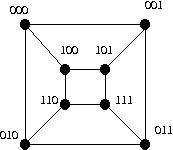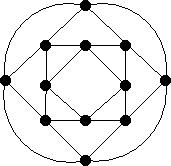MTH 607 Graph Theory Lab 9
We will work on these questions in the lab.
-
For each of the graphs below:
In Each case state whether the given graph is
- State whether it is Eulerian, giving reasons.
- State whether it is Hamiltonian, giving reasons.
- Give the Hamiltonian closure.
In each case either give the relevant cycle or explain why it does not
exist.




- (Ex 6.12)
Let G be a 3-regular graph of order 12 and H
a 4-regular graph of order 11.
- Is G + H Eulerian?
- Is G + H Hamiltonian?
-
-
For what values of n and m is Kn,m Eulerian?
- Find Conditions on n and m so that Kn,m
is guaranteed to be Hamiltonian?
-
Consider the graph Q3 below.
For each of the matchings given below
- Find an M-alternating path which is not M-augmenting.
- Find an M-augmenting path P.
- Use P to produce a larger matching.

- M = empty.
- M = { (000, 010), (111, 011), (110, 100) }
- M = { (011, 001), (110, 010), (110, 100) }
-
Find the size of a maximal matching in each case:
(Hint: Consider the cases n odd and n even separately.)
- Kn
- Cn
- Pn
- Kn,m
-
For this question we assume that T is a tree with a perfect matching M.
- Show that every leaf in T has a unique parent.
-
Show that the graph formed by deleting all the leaves of T
and their parents has a perfect matching.
-
Use the above results to create an algorithm for finding a perfect matching
on a tree or determining if one does not exist.
-
Conclude that every tree has at most one perfect matching.
Peter Danziger, March 2008








